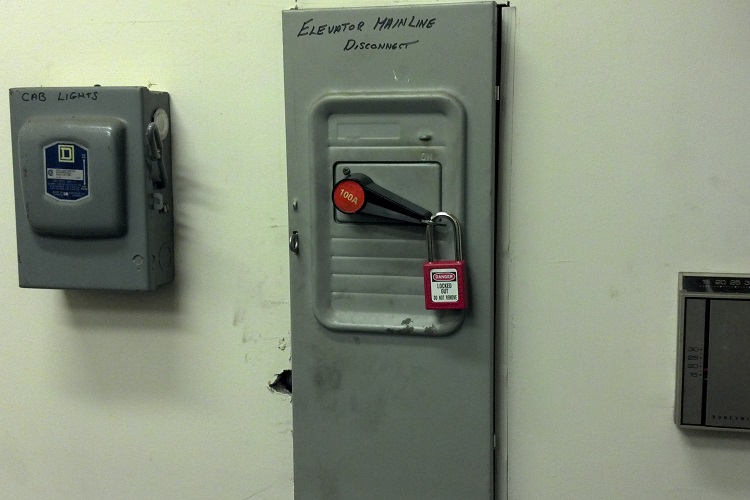
By Mark van der Feyst
In December 2018, I responded to a call with people trapped in an elevator. While en route to the address, there was no further information relayed from dispatch. As it turned out, the elevator was in a seniors residence building, which was about five stories tall. The elevator was a single elevator servicing the entire building. The first apparatus arrived on scene and was met with the building superintendent to ascertain more information about the elevator entrapment. At the same time as the other two trucks arrived on scene, we received another call for the same building address for an automatic alarm that was triggered by the elevator machine room.
With these two calls happening simultaneously, we created two sets of crews to deal with each call. The first-arriving crew dealt with the elevator entrapment while the other two crews from the other two arriving units dealt with the automatic alarm. The elevator company was called to respond to the building for its service expertise, with an estimated time of arrival of about one to two hours. The elevator crew grabbed the elevator rescue equipment, which included a lockout tag out box, a flashlight, elevator keys to open the doors, and portable radios for communication. Two members of the elevator rescue team went to the third floor, where the elevator was stopped, while the other two crew members (including the officer) went up to the elevator mechanical room.
On the third floor, crew members approached the elevator door and made verbal contact with the occupants inside. This was accomplished by, banging on the elevator door with their hands and then verbally speaking to the occupants. Right away, we asked the occupants about any medical problems to ascertain if there was an immediate need for removal. All three occupants replied that they were okay, and no medical problems were present.
We opened the elevator shaft door with the elevator keys using the small circular hole at the top of the door. Once that door was opened, the elevator door itself was able to be opened. We kept both doors open with two door wedges or chocks (photos 1, 2).
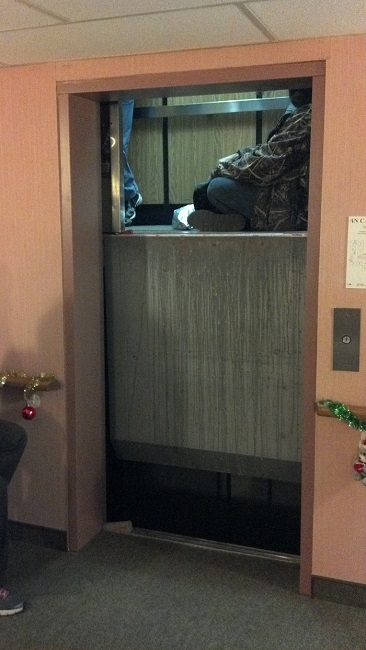
(1) Photos by author.
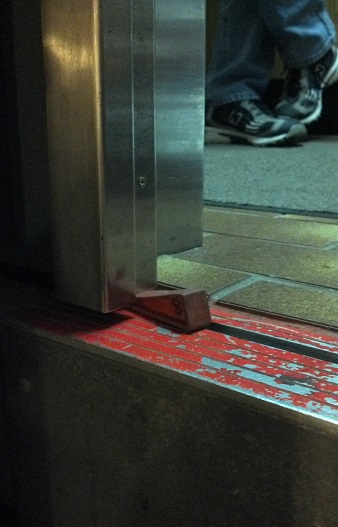
(2)
Photo 1 shows that the elevator was stopped between the third and fourth floor. There was only a small space of about 2½ feet available to reach the occupants. All occupants were told to stay in the elevator for their safety until we were certain it would be safe to remove them. At the same time, crews assigned to investigate the automatic alarm went up the elevator mechanical room, where they discovered a small amount of smoke inside. The smoke detector inside the room had been activated; the motor used to operate the elevator overheated because of a mechanical fault and shutdown, locking the elevator in the position found on the third floor (photo 3).
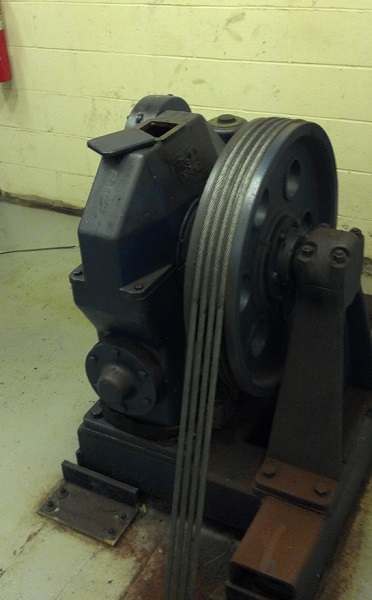
(3)
The crew assigned to the elevator mechanical room locked out the main power supply to the elevator (photo 4).
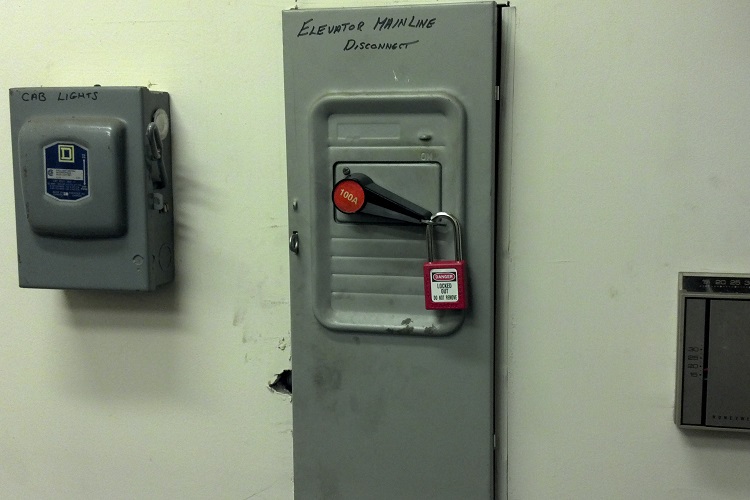
(4)
The officer held the key to the padlock. We verified that the elevator’s brakes were checked to make sure that they had locked and were holding the elevator in place; we did this by using a piece of paper to see if there was any space between the brake pad and the brake drum. The brake pad is the blue square in the middle of the picture resting against the shiny steel (photo 5). The brakes were set and locked in place.
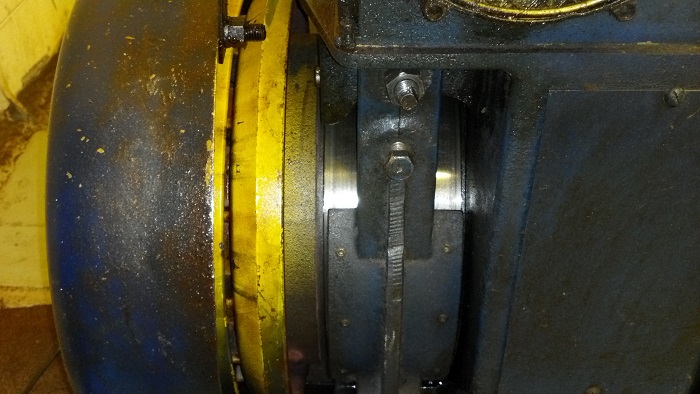
(5)
Once all safety systems were in place and verified by the officer (who also acted as our elevator rescue shift instructor), we removed the three occupants from the elevator one at a time without any injury or instance. They all carried on with their day with gratefulness.
The elevator was placed out of service, and the padlock was kept in place until the elevator company technician arrived on scene. Once there, he removed the padlock and replaced it with his set of padlocks.
Although this was a technical rescue call mixed with a general response call (for the automatic alarm), the situation was handled by using basic tactics such as establishing communication with the elevator occupants, determining if medical attention was needed, locking out the elevator’s main power supply, and communicating all actions between the crews. Also, it made a big difference having a person trained in elevator rescue on scene; it will allow you to execute this type of operation if you ever respond to one.
Opening the elevator doors is part of the technical rescue operation. This process can vary from elevator to elevator depending on what type of access is present for the fire department or elevator technician. This elevator door had a small hole at its top, allowing the elevator key to penetrate through. What also helped that day was the training conducted on that particular type of door at another facility a few weeks prior. They had practiced opening the door using the various types of elevator keys to see which one worked best and to get familiar with that type of mechanical operation. That training had paid off with the quick execution of opening the elevator doors at the senior’s complex.
No matter what type of department you may work with or for, there may be the possibility of an elevator present within your response area. If this is the case, training on this type of situation will help in making a call successful if one is ever received by your department.
 Mark van der Feyst has been in the fire service since 1999 and is a full-time firefighter in Ontario, Canada. He is an international instructor teaching in Canada, the United States, and India, and at FDIC. Van der Feyst is a local level suppression instructor for the Pennsylvania State Fire Academy. He is also the lead author of Residential Fire Rescue (Pennwell).
Mark van der Feyst has been in the fire service since 1999 and is a full-time firefighter in Ontario, Canada. He is an international instructor teaching in Canada, the United States, and India, and at FDIC. Van der Feyst is a local level suppression instructor for the Pennsylvania State Fire Academy. He is also the lead author of Residential Fire Rescue (Pennwell).
MORE MARK VAN DER FEYST
Firefighting Back-to-Basics: Standpipe Systems
Truck Company Ops: Fireground Communications
Engine Company Ops: Hydraulic Ventilation
Truck Company Ops: Cutting with the Ventilation Saw


